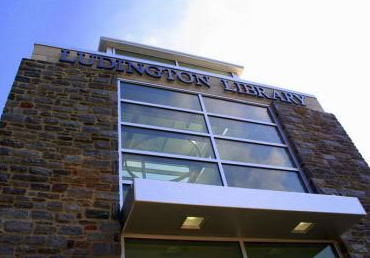Bryn Mawr’s Ludington Library remains a vital part of the community 
By Deeksha Raina
On a Wednesday afternoon in the Ludington Library in Bryn Mawr, there isn’t a single empty table in sight. Every table, including the ones tucked away in remote corners of the library, has at least one occupant, ranging from small children laughing over a picture book to college students furiously typing away on their laptops, head bobbing to whatever tune is blasting through their earphones.
In the airy indoor reading porch, an elderly couple sits together sipping on coffee and thumbing through their books. A few tables away, a high school student practices speaking in French with her tutor. Despite it being a weekday afternoon, the library is bustling and full of life.
The Ludington Library, one of the libraries of the Lower Merion Library System (LMLS), is just one of many that have managed to keep the library relevant to the community in the new digital age.
Roz Warren, a library assistant at the Bala Cynwyd Library, another library in the LMLS, noted, “In the old days, when there was no internet and you had to write a report or research paper, you would come into the library to find research material. But now that’s not really the case.”
Public libraries are no longer document-centric, shifting towards a user-centric model instead. It’s no longer about the books that libraries have. Rather it’s the range of services one central location can provide for its community.
Today, libraries provide so much more than just books and dvds. The Ludington Library, among others, provides community members with meeting rooms, access to computers, wifi, tax forms, and even baking pans shaped like teddy bears and trains. And of course, the library provides students with a much-needed quiet environment to study.
The Ludington Library is not alone in these changes. In 2015, the American Library Association (ALA) president Sari Feldman said, “Today libraries are less about what we have than what we can do with and for our patrons.”
 Public libraries have added computers, wifi, access to printing services, and digital literacy programs to the core of their services. Unsurprisingly, with such additions to the library, visitors continue to stream in and the data is there to back it up. In 2012, the American Library Association found that there was a 54.4% increase in visitors to public libraries over the past ten years.
Public libraries have added computers, wifi, access to printing services, and digital literacy programs to the core of their services. Unsurprisingly, with such additions to the library, visitors continue to stream in and the data is there to back it up. In 2012, the American Library Association found that there was a 54.4% increase in visitors to public libraries over the past ten years.
In 2008, only 52% of libraries offered ebooks. In 2014, that number rose to 90%, and only continued to rise in the following years. More recently in 2016, OverDrive, the provider that a majority of public libraries use to distribute ebooks and audiobooks, published an extensive survey on digital ebook and audiobook usage in public libraries in the United States. The survey found that more than 120 million ebooks and audiobooks were borrowed in the first nine months of 2015 alone, which is a growth of just under 20% from the previous year.
A similar survey in 2017 found that OverDrive hosted 4 million different titles available for download in over 100 languages. The growth of ebook downloads was also very noticeable, a sizeable 14% growth from 2016. That’s 225 million titles downloaded in 2017 alone.
Ludington Library uses both OverDrive and a similar service called Hoopla to provide electronic access of media to its community. OverDrive is specifically for audiobooks and ebooks, whereas Hoopla offers movies, music, and books. In 2018, Ludington Library had to limit usage of Hoopla to 9 downloads per month due to it’s overwhelming popularity. OverDrive comes close, but currently does not have a limit on ebook or audiobook downloads.
Technology aside, library programs continue to draw community members to the library. In 2017, the Ludington Library hosted 499 events with 17,000 people participating in those events. They ranged from traditional events such as book talks and author talks to broader ones such as digital media literacy programs and craft fairs. According to a report released by the ALA in 2015, “traditional library programs, from story times to author talks, have always been popular with patrons. New forms of programming today, from makerspaces to drop-in craft activities reflect our changing world.”
Other services include simply functioning as a safe space for community members. In August 2014, when protests about the Ferguson shooting caused schools and other public offices in Ferguson to shut down, the Ferguson Municipal Public Library stayed open as a safe space and provided an area for community members to hold meetings, teachers to have an area to continue teaching students, and helped provide support for community members.
There’s been a clear and steady increase in the usage of libraries from the past ten-fifteen years, and it doesn’t appear to be slowing down. As long as libraries can continue to adapt and provide for the needs of their community, they’re not going anywhere anytime soon.
